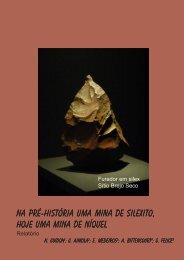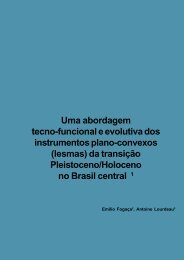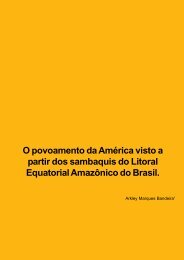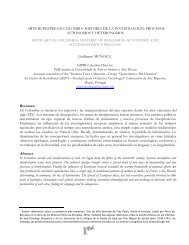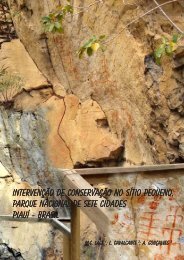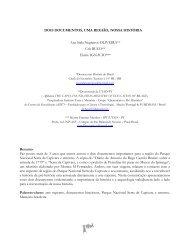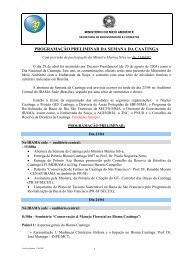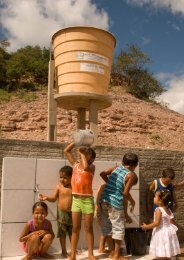Untitled - Fundação Museu do Homem Americano
Untitled - Fundação Museu do Homem Americano
Untitled - Fundação Museu do Homem Americano
Create successful ePaper yourself
Turn your PDF publications into a flip-book with our unique Google optimized e-Paper software.
Arquitetura, concreta e abstrata, na Pré-história<br />
Cris Buco, Elaine Ignácio & Mafalda Sofia Fidalgo. Brasil & Portugal<br />
Há a conservação região <strong>do</strong> espaço sagra<strong>do</strong> numa perspectiva de transformação da paisagem?<br />
Nesta comunicação será apresentada uma breve discussão teórica sobre os primórdios da arquitetura<br />
evidenciada pela relação arquitetura e arqueologia, esta demonstrada pelo fato da existência de<br />
representações gravadas (Europa) e pintadas (região da Serra da Capivara) das formas arquitetônicas<br />
e <strong>do</strong> ordenamento espacial para tal uso.<br />
(Artigo 95 IFRAO2009)<br />
“On perpetual motion”: animation in the Palaeolithic Côa Valley rock art<br />
Luís Luís & António Pedro Batarda Fernandes, Portugal<br />
There are several examples of ‘animated’ rock art motifs within the Côa Valley rock art complex in Portugal<br />
(http://www.ipa.min-cultura.pt/coa/). We aim to illustrate the most significant ones (such as the example<br />
shown below) proposing that, as Marc Azéma (2005) noted, animation was indeed invented in the Upper<br />
Palaeolithic. Moreover, we believe that even motifs where no discernible motion can be detected also<br />
entail the depiction of movement. We suggest that motifs in which animals that are portrayed as being<br />
still <strong>do</strong> comprise significant clues of prior or subsequent movement.<br />
(Artigo 96 IFRAO2009)<br />
110<br />
Análisis de las representaciones de rostros en el semiári<strong>do</strong> chileno, comparación entre los<br />
Valles de Limarí y Choapa<br />
Paula Urzúa, Chile<br />
Se explora la posibilidad de que las diferencias identificadas durante la secuencia alfarera (perío<strong>do</strong>s<br />
Alfarero Temprano, Intermedio Tardío y Tardío) entre los valles de Limarí y Choapa, norte semiári<strong>do</strong> de<br />
Chile, se exprese también en el registro rupestre, específicamente en el motivo de las comúnmente<br />
denominadas “máscaras”, a las que preferimos llamar representaciones de rostros. Utilizan<strong>do</strong> como<br />
marco de referencia el concepto de estilo se analizan los atributos de estas representaciones para<br />
intentar una definición estilística que nos permita asociarlas a uno u otro perío<strong>do</strong>, se presentan los<br />
resulta<strong>do</strong>s preliminares.<br />
Movement and Compositions in Rock Art of Gobustan (Azerbaijan)<br />
Farajova Malahat, Azerbaijão<br />
Dynamics of images is one of the brightly expressed features in the subject-matter of Rock Art of Azerbaijan.<br />
We should note that Rock Art of Gobustan covers wide range of time: since Upper Paleolithic up to Middle<br />
Ages and dynamics of images of each period differs with peculiar styles.<br />
Let us begin with images of wild oxen-aurochs. On the upper terrace of Beyukdash Mountain an aurochs<br />
drinks water having bent his head. On the lower terrace one can see a running aurochs. Very interesting is<br />
the image of a roaring aurochs on Kichikdash Mountain. These wild aurochses are depicted in a realistic<br />
manner. In “Ana-zaga” cave a primitive artist tried to reflect the volume and space by having depicted<br />
a herd of aurochses. In the study of dynamics of movement the depiction of swiftly running gazelles in<br />
“Gaya-arasi” cave on Kichikdash Mountain arouses a special interest. In the plots of petroglyphs of Neolithic<br />
period and Bronze Age of Azerbaijan, according to the manner of execution petroglyphs acquire more<br />
schematic shape, rather than images of Upper Paleolithic and Mesolithic epochs. According to stylistic<br />
features images of the given period can be divided into 2 groups. We should also note that among<br />
petroglyphs of Bronze Age new motives appear: images of carts, riders. Dismemberment of animal bodies<br />
with numerous geometrical figures is characteristic of graphic manner. Monuments of early Iron Age and<br />
Middle Ages period are characterized with considerable changes in the rock art of Gobustan. Images<br />
become even more schematic. New stylistic manner of image depiction appears. Composition scenes<br />
are also rather a frequent plot in the themes of rock art of Azerbaijan. While considering separate plots,<br />
which one can distinguish in the material on rock images, it is evident that the most ancient images are<br />
FUMDHAMentos IX




